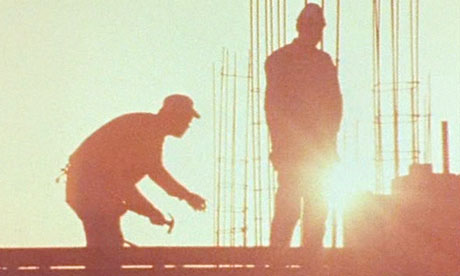
Did Susan Sontag enjoy making Promised Lands, her fragmented documentary about the 1973 Yom Kippur war? Shortly after its completion, and its less than enthusiastic reception, she wrote: "Film-making is nitpicking, anxiety, fights, claustrophobia, exhaustion, euphoria. Film-making is catching inspiration out on the wing. Film-making is flubbing the catch, and sometimes knowing the fool that's to blame is yourself. Film-making is blind instinct, petty calculations, smooth generalship, daydreaming, pigheadedness, grace, bluff, risk."
It can't have been easy for her. Sontag, who died in 2004, was best known as the "dark lady of American letters", the producer of influential essays, novels, short stories and plays. But in writing so authoritatively about culture, photography and every aspect of cinema, from sci-fi to the nouvelle vague, she set herself a daunting task when it came to stepping behind the camera and becoming a lady of images. None of which stopped her having a go.
It is a little known fact that Sontag made four feature films of which the third, Promised Lands, is the most remarkable. The first two were sub-Bergman Swedish-language dramas, the fourth an adaptation of her short story Unguided Tour, a break-up tale set in Venice. Promised Lands concerns the 20-day Yom Kippur war that saw Egypt and Syria uniting to make a surprise attack on Israel. Before the conflict had even ended, Sontag had left the cosy world of the New York Jewish intelligentsia to go out there and document what she saw.
Sontag was no stranger to adventure: she had written her Trip to Hanoi a few years earlier. But, creatively, this journey took her even further out of her comfort zone. At the time, she was writing On Photography, her celebrated series of essays outlining the very issues she would find herself grappling with on the ground in Israel. She wrote of photography as "a powerful instrument for depersonalising our relationship to the world". She questioned the proliferation of images of horror and suffering. She warned that photographic knowledge "can never be ethical or political knowledge". She compared cameras to guns. Then she went to Israel and filmed bullet-riddled tanks and the charred remains of soldiers.
Just as Sontag's writing was heavily informed by such European thinkers as Roland Barthes and Walter Benjamin, so Europe's auteurs became her cinematic guides, particularly Jean-Luc Godard. Sontag had praised Godard's 1962 film Vivre Sa Vie (It's My Life), about a Parisian woman's descent into prostitution, told through 12 basically unconnected scenes. She called it "an exhibit, a demonstration. It shows THAT something happened, not WHY it happened", just as she had written: "To interpret is to impoverish, to deplete the world."
Accordingly, Promised Lands is less straight documentary than visual collage. There are images of combat zones and soldiers, but also everyday street life, desert landscapes, funerals, supermarkets, the Wailing Wall. The soundtrack is snatches of radio, bursts of church bells and gunfire, and an extended voiceover from two politically opposed Israeli thinkers, physicist Yuval Ne'eman and writer Yoram Kaniuk, who says: "The Jews never understood tragedy."
At times, though, it's unclear exactly what we're seeing or who we're hearing, especially 40 years on. Sontag herself was probably unclear, says Ella Shohat, an Israeli film scholar who will introduce Promised Lands when it plays at the Palestine film festival in London this week. "I don't think she knows Israeli society well in terms of ethnic belonging, class, language, dialects, accents. And there is no reason for her to. It was really a film about Israel [seen by] an American Jew who was not involved necessarily in Judaism or Zionism."
Sontag's attempts at Godardian neutrality are ultimately compromised, says Shohat: "The film is not multi-voiced, literally or metaphorically." No Palestinians are heard, nor any women. Instead, Israel's complex situation is represented by two men, Ne'eman and Kaniuk. "She shifts into a very traditional talking-heads documentary mode when she interviews them – exactly the kind of thing Woody Allen makes fun of in Zelig." Shohat is referring to the fact that Allen's spoof 1983 documentary about a human chameleon actually features a game cameo from Sontag as a talking head.
But Promised Lands benefits from Sontag's outsider's eye on how Israel represented itself to itself. There are shots of posters, street signs, slogans – image systems within the film's own image system. Some of its most moving scenes involve a montage of exhibits at a bizarre museum of waxworks, presenting Israeli history in heroic tableaux of Jewish victimhood. And in the film's disturbing climax, we visit a clinic that attempts to cure soldiers' post-combat psychological disorders by dosing them with drugs and simulating warfare. The patient buries his head in his pillow while doctors bang doors and play tapes of gunfire – an ironic battle re-creation that seems more torture than therapy.
Thanks to such unflattering scenes, Promised Lands was banned in Israel. It was not particularly well received in the US either. "Perhaps [it] should have been a book instead of a film," the New York Times sniffed. But Sontag's chief aim was to "represent a condition, rather than an action". And, for all her stumbles, she succeeded. The 1973 war had left Israel in a state of demoralisation and disillusionment for the first time since its formation. Israeli cinema itself would not register that change for another decade.
Sontag barely returned to the medium. Perhaps she was disappointed by the lack of critical praise, to which she'd become accustomed. Perhaps she found it easier to write about the problems of cinema than resolve them first-hand, but the fact that she even tried sets her apart from the majority of critics, theorists, journalists and all those who cast judgment on the world of images from the world of letters. Sontag put her money where her mouth was – grace, bluff, risk and all.
• Promised Lands is at the Barbican, London EC2, on 25 April. The Palestine film festival runs until 3 May.

